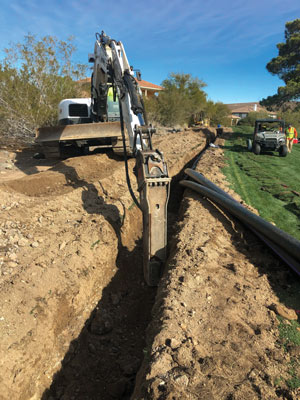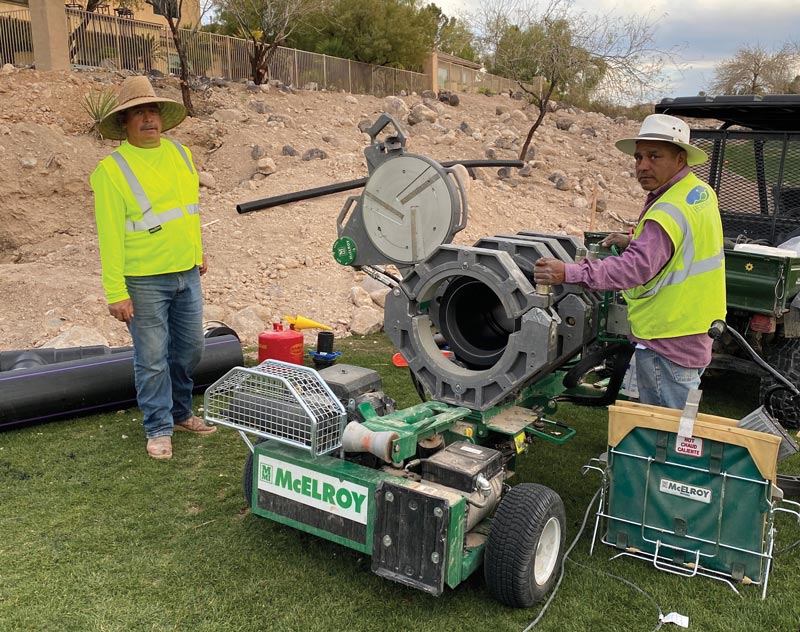
A much-needed irrigation upgrade that was years in the making is finally a reality at Anthem Country Club, an 18-hole layout near Las Vegas, and the results have been dramatic from both an agronomic and an operational standpoint. Photos courtesy of James Symons
When James Symons arrived at Anthem Country Club in 2018 to take over as its GCSAA Class A golf course superintendent, he hadn’t traveled far. He had spent the previous four years right across the street at Revere Golf Club, a cousin to his new posting in more ways than one. Del Webb had developed both properties, and both occupy the same dramatic, rock-strewn desert terrain south of Las Vegas. And both sported irrigation systems that weren’t nearly up to the task.
The system at Anthem was a particular problem, 23 years old by that time — a lengthy tenure indeed in a place where water quality issues and 24/7 irrigation cycles prevail. The system had not been properly looped, meaning part of it meandered off into the landscape before dead-ending. This only exacerbated the most debilitating issue: pressure. The low point on this Hale Irwin/Keith Foster routing sits at 2,600 feet above sea level. The high point, the 15th and 16th holes, climbs to nearly 3,000.
“That’s a lot of elevation for any pump to deal with,” says Symons, a 19-year GCSAA member. “We couldn’t run any heads at night on those holes, when the high-zone portion of our system was running. It made overseeding so difficult. It made everything difficult. There was simply not enough volume to deal with summer hot spots. We were constantly hand-watering and babying those areas. This was true all over the golf course, but especially up at No. 16.”
Today, Symons can look back on this situation with a wisdom and good humor born of distance. After years of discussion, dramatic changes in plan and scope, a complete management overhaul, and fears of a membership exodus, the club broke ground on an irrigation renovation project in November 2019.

Right: James Symons, GCSAA Class A superintendent at Anthem Country Club.
Symons went with the IC System from Rain Bird. Heritage Links, a Houston-based contractor, installed it. The coronavirus pandemic hit about halfway through the process, yet that didn’t stop all affected holes from reopening May 1.
In early August 2020, general manager Shelley Caiazzo was still a bit awed by the extent of the turnaround at Anthem — agronomically, operationally and psychically.
“We typically do 2,900 rounds in June. In June 2020, we did 4,200, and July will be much the same,” Caiazzo explains. “When things shut down, golf was the only amenity open, and our members were exhausting the tee times.
“The pandemic honestly worked in our favor in another way. For three solid weeks in April, the golf course was closed. It grew back in so beautifully, on account of proper irrigation and so little traffic. The golf course has never looked better. The membership has never been happier.”
However, as Caiazzo and Symons would be the first to tell you, starting this story in November 2019 and fast-forwarding to August 2020 leaves out the nitty and gritty portions of a long, convoluted but ultimately instructive narrative.
A long time coming
Symons’ predecessor started to see signs of irrigation failure in 2014, and the compromised nature of the system should surprise no one. Las Vegas may be the most demanding golf course irrigation market in the country. The soil is terrible for growing grass. It’s even worse when it comes to laying new irrigation pipe, thanks to all the rock and caliche, a naturally occurring calcium carbonate that binds to other materials like concrete. The water quality is no bargain, either. It takes a heavy toll on systems that, because of the arid climate, are running every night, all year long.
By 2018, everyone at Anthem knew the old system was on its last legs. But because of these geographic factors and a host of others, the prospect of replacing it had essentially spooked and paralyzed the entire club ecosystem. Staff and membership could see course conditions were suffering, but replacing the irrigation system raised the specter of a massive member assessment to cover the cost.

Poor water quality, 24/7 irrigation cycles, significant elevation changes and rocky soil were all factors that contributed to Anthem Country Club’s former irrigation system’s floundering.
In the end, the irrigation renovation that threatened to sink the club saved the club. And John Pollok, Rain Bird’s district sales manager, is pretty sure he knows why.
“The biggest problem in Las Vegas isn’t the soil or the quality of the water — it’s the cost of that terrible water,” says Pollok, a former golf course superintendent. “I managed Spanish Trail Country Club for three years and rebuilt 27 holes there. When you look at the cost, it was $1.3 million each year for water and the power to push it. We were spending $42 for every person who played the course, just for water and power. And that puts enormous cost pressure on everything else you do at a club.
“It’s expensive to install a new irrigation system anywhere, especially in Las Vegas. But in the end, you have to look at what an old, inefficient, leaky system is costing you. I sell irrigation systems, but these are the facts. And if you can identify the right people at a club and show them the facts, they might just start to listen. The folks at Anthem did. Eventually, they understood that if they put several million into an irrigation system, they would actually recoup that cost in 10 years.”
Turning the tide
In retrospect, it’s stunning to observe just how far from this realization the brain trust at Anthem had been — technically, financially and operationally — as recently as March 2018. “The irrigation renovation had been up for discussion with the board for several years by that time,” says Caiazzo, who served as membership director prior to 2018. “Financially, they just couldn’t make it work.”
One reason the numbers didn’t work was how the proposed system was being considered.
“My colleague, Bob Bryant, was first contacted about this job in 2016,” says Dave Taylor, an irrigation designer with Costa Mesa, Calif.-based Bryant Taylor Gordon Golf. “They were looking at doing this project in four phases back then — fresh water for the greens, high zone reclaimed, low zone reclaimed, then clubhouse and fitness center. They talked first about a complete replacement. That was too expensive, so then they talked about fixing only the problem areas. It started to get real complicated.
“By the time it first went out to bid, in early 2018, contractors were being asked to bid on multiple options on a single golf hole. With the original phasing plan the club wanted to pursue, the contractor would have needed to dig through many of the golf holes multiple times, destroying and repairing work done in earlier phases. Just not a very workable plan.”
Not surprisingly, that bid process went poorly. This added another layer of pressure to the club’s management team as the course fell ever further into disrepair. Fixing that situation was going to cost a lot of money — and the membership was not thrilled with the idea of footing that bill.
“I was the membership director at the time, and I can tell you, the club was struggling,” Caiazzo recalls. “People in key positions were resigning right and left. The golf course had become virtually unplayable the summer before. That started the ball rolling, and it just kept going south.”
The superintendent and general manager resigned that spring of 2018. Symons arrived from across the street, and Caiazzo from just down the hall. The board at Anthem also saw fit to retain Arnold Palmer Golf Management/Century Golf Partners to consult on club matters, which, at a private club, as Caiazzo would be the first to tell you, are really just membership matters.
“APGM came in and said, ‘Here’s what we’re looking to do: We need to sell this number of memberships at this price, which will generate the additional capital dollars needed to kick-start this irrigation project without an assessment,’” she says. “And that’s exactly what happened. They arrived in May 2018, and we began the membership drive that September. Then it just took off. We added 50 new members in the course of that year.”
News of these sales — and the fading specter of some massive irrigation-related assessment — had an immediate effect on the existing membership, Caiazzo says. Rampant gossip about a potential assessment/exodus was replaced by the will to move ahead with what needed to be done.
Solving Anthem Country Club’s irrigation puzzle
Of course, the attitudinal change within the club did nothing to mitigate the complicated engineering at play here.
“I don’t think it’s possible to underestimate the importance of a good irrigation design. That’s true anywhere, but it’s especially relevant on a site like the one at Anthem,” says Tim Hubbard, vice president of irrigation services at Heritage Links, which handles dozens of irrigation-specific renovations each year. “James Symons is a very bright guy. He and the team at Anthem knew from a commonsense standpoint what needed to be done. But there are huge intricacies to address on a job like this one, and Bob Bryant was the guy who put the pen to paper and did the math.”

Right: Scenes from the irrigation system renovation at Anthem Country Club.
A lot of that math was related to pipe diameter and the impact on system performance. “Rain Bird heads require 60 to 70 psi just to pop open and run,” Hubbard says. “Bob had to design a system to go up the hill and account for the entire system but also all the friction loss. That was part of the problem with the old system. There was a lot of 3- to 4-inch pipe out there.”
When water is pushed through piping, friction is created as the water rubs against the internal pipe circumference. That friction, in turn, creates pressure loss. The faster the water passes through the piping, the more friction loss results.
The problem is compounded by smaller pipe sizes, Hubbard says. Doubling flow in larger pipe means less friction loss. Symons and Bryant went with 16-inch pipe down to nothing smaller than 6 inches on the new system (the old system ranged from 14 inches down to 3), an example of long-term decision-making in action, because 16-inch pipe is more expensive than, say, 12-inch pipe.
Editor’s note: To tackle irrigation system deficiencies at the root — rather than just reacting to them — a Colorado superintendent put his turf to the stress test. The results debunked some long-held beliefs. Read more in An irrigation evaluation.
In nearly every respect, long-term thinking won out over short-term thinking on the Anthem job. The Heritage Links team even prevailed in persuading the homeowners association at Anthem to do the right thing. “We worked with the HOA on a number of matters, but the road crossings were critical,” Hubbard says. “There were no less than six of them. We considered using the existing PVC that ran under those roads, but as I said to James, ‘I’d hate to see you spend all this money and have the PVC under the road fail.’ We got the HOA on board. When everything is new, there is far less to worry about.”
Planning pays off
Neither Caiazzo nor Symons had any interest in coming at this renovation piecemeal. Four phases would never have worked. However, they did resolve to break the project into two phases. The “high zone” at the highest elevation would be tackled first at a cost of just under $4 million. The club used the membership boost to pay for most of that sum. It borrowed the rest and today is dismissing that debt with double payments, Caiazzo reports. The second phase, tackling the lower-lying holes, may be undertaken as soon as 2021.

“Every year, we were putting Band-Aids on that old system,” says Caiazzo, who adds that Bud White, the national agronomist with Century Golf Partners, proved another valuable resource during the planning stages. “We had to ask ourselves, ‘Do we want to wait until it crashes?’ No. We made that determination and laid it out to the board and the membership. We felt it was critical to go forward with this.”
Once again, they found an able ally in Bob Bryant.
“With the management changeover, Bob recognized the opportunity to change course,” Dave Taylor says. “We also ended up changing direction in irrigation products to fit with the desires of the new superintendent. This resulted in a completely new set of irrigation control system plans. They went from a central-satellite system to a two-wire (decoder) system. This also resulted in the need to integrate the old system still in use on the low zone with the new system being installed on the high zone, as each system is inherently different in how it operates within the irrigation computer.
“I am completely convinced that the only reason the project got done at all and was such a complete success was the diligence and tenacity Bob displayed in dealing with all the changes in direction this project took, then coming up with a project strategy that was both workable and cost-effective.”
A booster pump from Watertronics was ultimately included in Bryant’s design, to improve pressures at the highest elevations. Heritage Links broke ground in early November 2019. With that, Jorge Garcia, the firm’s superintendent on-site, set about tackling all the typical things that make irrigation renovations in Vegas such a trial — road crossings, the caliche, the tight hole corridors, the terrible soil, the poor water quality, and, lest we pay it too little attention, the damned caliche.


Houston-based contractor Heritage Links provided construction services for the new Anthem Country Club irrigation system.
According to Symons, “It takes a talented crew that respects the golf course to be able to bust out the caliche, install the pipe and put the grass back like nothing had been done there. Heritage has confidence and efficiency born of really knowing what they’re doing.”
High praise, but this leaves out perhaps the most important contractor obligation — the tightrope that is keeping the old irrigation system running while installing the new one. “We had an irrigation break one day on the old system,” Symons recalls. “The Heritage guys came over, dug it up and fixed it. No charge. It would’ve been beyond us.”
A fitting tribute to Bob Bryant
By now, you may have noticed that, among all the people who helped make the Anthem Country Club irrigation renovation a success, we’ve not yet heard from Bryant himself. That’s because he never saw the finished product and precious little of the installation, both of which relied so heavily on his ingenuity.
“We lost Bob halfway through the construction process in mid-December 2019,” Taylor says. It was a lung condition, sudden and unexpected. “A lesser personality would have just kept the project as the owners originally envisioned it. Namely, keeping a lot of the existing system, patch-working adjustments in certain areas, and building the project in four phases, presumably over a four-year period. In my opinion, whether they are aware of it or not, the ownership has Bob to thank for many of the changes in direction that brought the project to where it ultimately landed.
“He and I were friends over 45 years — friends well before we were business partners, our entire adult lives,” Taylor continues. “Bob was a captain in the Marine Corps, something that defined a lot of who he was in his adult life. But he was the smartest guy I knew, so far as irrigation goes. Just a really good handle on product materials and solutions, any irrigation system, golf or commercial or residential. Such a bright guy. So well respected by pretty much everyone in the industry. He could be tough, but always fair. Right on target about what should be done. Irrigation was his passion. He just knew everything there was to know about it. Bob was very active with the Golf Course Builders Association of America, and he really enjoyed the industry — but like me was a horrible golfer.”
The GCBAA publicly mourned Bryant’s passing 12 months ago, noting his long involvement on its board of directors, the board of governors and the Rossi Award committee. He was also instrumental in the development and expansion of the “GCBAA Cost Estimating Guide for Golf Course Construction,” and he helped author the GCBAA Golf Course Irrigation Contractor Certification Program.
“Bob worked on probably a third of the golf courses we designed,” Jack Nicklaus shared via the GCBAA Facebook page the week of Bryant’s passing. “I’ve always said that what goes on top of the ground is my vision. But there are a lot of talented people who work very hard on what goes beneath it. Bob was certainly one of those key individuals. He will be missed.”
Hal Phillips is the managing director of golf and resorts for Mandarin Media, a public relations firm with offices in Portland, Maine; Park City, Utah; and Ho Chi Minh City, Vietnam. He is the former editor of Golf Course News.